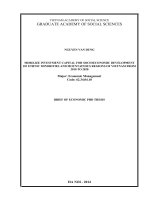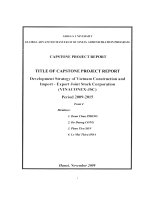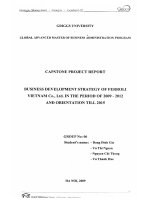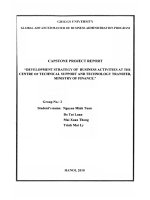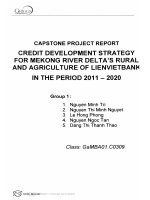Individual credit development strategy of Vietcombank from 2013 to 2018
Bạn đang xem bản rút gọn của tài liệu. Xem và tải ngay bản đầy đủ của tài liệu tại đây (2.7 MB, 141 trang )
Group 6 - Class GaMBA01.C0211 Thesis - Strategic Management
i
Andrew University
GLOBAL ADVANCED MASTER OF BUSINESS
ADMINISTRATION PROGRAM
TOPIC
INDIVIDUAL CREDIT DEVELOPMENT
STRATEGY OF VIETCOMBANK
FROM 2013 TO 2018
Group No. : 6
Group members : Nguyen Quoc Toan
Nguyen Van Cuong
Nguyen Thi Le Khanh
Le Thanh Vinh
Nguyen Duc Thang
Vo Van Tam Thanh
Class : GaMBA01.C0211
HCMC 12/2012
Group 6 - Class GaMBA01.C0211 Thesis - Strategic Management
ii
ACKNOWLEDGEMENTS
The whole group 6 – Class GaMBA01.C0211 we would like to thank to all
Lecturers of Global Advanced Master of Business Administration training programs
of Griggs University – The United States has created the best conditions in studying,
researching and communicating valuable knowledge to us during studying time;
Our group members also would like to thank to Leadership Board and VCB
colleagues who have supported and created favourable conditions for us to collect
data for researching and completing this thesis.
HCMC, 25
th
of Dec, 2012
Performers
The authors
Group 6 – Class GaMBA01.C0211
Group 6 - Class GaMBA01.C0211 Thesis - Strategic Management
iii
INDEX
THE BEGINNING 1
CHAPTER 1.BRIEF THEORY 5
1.1. OVERVIEW OF INDIVIDUAL CREDIT PRODUCTS OF COMMERCIAL
BANKS 5
1.1.1. Individual credit concept 5
1.1.2. Characteristics of individual credit 7
1.1.3. The role of individual credit in the economy 8
1.1.4. Current individual products in Vietnam 9
1.2. LITERATURE REVIEW OF STRATEGY AND STRATEGIC PLANNING
10
1.2.1. STRATEGY AND STRATEGIC MANAGEMENT: A DEFINITION . 10
1.2.2. The role of strategic management 12
1.2.3. Business strategies in reality 13
1.2.4. Competitive Strategy – Strategic Business Unit (SBU) 14
1.2.5. PROCESS OF PRODUCT STRATEGIC PLANNING IN
CORPORATION 16
SUMMARY OF CHAPTER 1 28
CHAPTER 2. ANALYSIS AND EVALUATION PATTERNS OF
INDIVIDUAL CREDIT ACTIVITY IN VIETCOMBANK 29
2.1. INTRODUCTION ABOUT JOINT STOCK COMERCIAL BANK FOR
FOREIGN TRADE OF VIETNAM (VCB) 29
2.1.1 History of the formation and development of VCB 29
2.1.2. Organizational structure, operating 30
2.1.3. Vision, mission and business mission of VCB 31
2.1.4. Business lines of the VCB: Include 31
2.1.5. The business strategy (SBU) of VCB: 32
2.1.6. Income statement of VCB: 33
Group 6 - Class GaMBA01.C0211 Thesis - Strategic Management
iv
2.2 SITUATION ANALYSIS ABOUT VCB’S INDIVIDUAL CREDIT
ACTIVITIES PERIOD FROM 2009 - 2011 34
2.2.1.Credit activities of the VCB 34
2.2.2. INDIVIDUAL CREDIT DEVELOPMENT ACCTUAL SITUATION IN
VCB 35
2.3. ANALYSIS ON OUT ELEMENTS IMPACT TO INDIVIDUAL CREDIT
ACTIVITY OF VCB 45
2.3.1. Analysis on general environment (Macro environment element) –
Applied PEST 45
2.3.2. Analyze business environment: 57
2.3.3. Opportunities and threats 71
2.3.4. Matrix of External Factor Evaluation (EFE) 72
2.3.5. Competitive profile matrix (CPM) 75
2.4. ANALYSIS ON INTERNAL FACTORS AFFECT VCB’S INDIVIDUAL
CREDIT ACTIVITIES 77
2.4.1. Human resources 77
2.4.2. Finance competency 78
2.4.3. Organizational Structure 79
2.4.4. Marketing Activity 79
2.4.5. Customer care 79
2.4.6. Research and develop individual credit product 79
2.4.7. Banking technology 79
2.4.8. Strengths and weaknesses of VCB on individual credit activity 80
2.4.9. Matrix for Internal Factors Evaluation (IFE) 82
2.5. EVALUATION ON SUCCESS AND RESTRAINTS OF CURRENT
INDIVIDUAL CREDIT DEVELOPMENT STRATEGY 84
2.5.1. Business results 85
2.5.2. Management, business organization model and human resources for
individual credit activity 85
Group 6 - Class GaMBA01.C0211 Thesis - Strategic Management
v
2.5.3. Customer quantity and distribution channels 86
2.5.4. Technology and product 86
2.5.5. Individual customer marketing 87
SUMMERY OF CHAPTER 2 87
CHAPTER 3.STRATEGIC MANAGEMENT VIETCOMBANK’S
DEVELOPMENT PLAN ON INDIVIDUAL CREDIT FOR PERIOD 2013 –
2018 89
3.1. VIETCOMBANK’S GOAL ON DEVELOPING INDIVIDUAL CREDIT
2013-2018 89
3.1.1. Particular targets: In order to have a clear and effective plan to develop
individual credit, Vietcombank has set the following specific targets: 89
3.1.2. Core goals for 2018: 91
3.2. ANALYSE THE STRATEGIES OF DEVELOPING INDIVIDUAL
CREDIT IN ORDER TO ACHIEVE THE TARGET 91
3.2.1. SWOT analysis: 91
3.2.2. Determine strategy of developing replaceable individual credit products
95
3.3. ANALYSE QSPM TO CHOOSE THE MOST APPROPRIATE
STRATEGY OF DEVELOPING INDIVIDUAL CREDIT 95
3.4. SOLUTIONS TO IMPLEMENT STRATEGY OF DEVELOPING
INDIVIDUAL CREDIT IN 2013-2018: 103
3.4.1. SOLUTIONS TO MOBILIZE SOURCES: 103
3.4.2. SOLUTIONS RELATING TO FUNCTIONS: 105
3.4.3. SOLUTIONS ON GENERAL MANGEMENT: 115
SUMMARY OF CHAPTER 3 122
CONCLUSION 123
APPENDIX 124
REFERENCES 132
Group 6 - Class GaMBA01.C0211 Thesis - Strategic Management
vi
LIST OF FIGURE AND TABLES
I.FIGURE
Figure 1.1 : Porter’s Generic Strategies 15
Figure 1.2 : General strategic management model 16
Figure 1.3: 5 forces model of competition 19
Figure 2.2 : Chart of population of Vietnam by sex and age 55
Figure 3.1. Proposed model on Individual Credit Department at Head Office 117
Figure 3.2: Proposed model on Individual Banking Department at branches 117
II.TABLES
Table 1.1 : External Factor Evaluation Matrix 22
Table 1.2: Competitive profile matrix 23
Table 1.3: Internal Factor Evaluation Matrix 24
Table 1.4 : SWOT matrix 26
Table 1.5 : Quantitative Strategic Planning Matrix 27
Table 2.1: Income statement of VCB (2009 – 2011) 33
Table 2.2: VCB’s outstanding loans classified by customers and business type 34
Table 2.3: Individual credit outstanding/ Credit structure by customers of VCB
(2009 – 2011) 36
Table 2.4: Bad debt –VCB’s individual bad debt (2009 – 2011) 37
Table 2.5 : Individual credit fluctuation chart owed bad of VCB in the year 2011 . 38
Table 2.6 : Individual credit of VCB by product 38
(2009 – 2011) 38
Table 2.7: Outline of individual credit of VCB by product year 2011 39
Table 2.8: Individual credit of VCB by geographic area 43
(2010 –2011) 43
Table 2.9 : Outline of individual credit of VCB by geographic area 44
(2010 – 2011) 44
Table 2.10: Proportion of the population by age through period 55
Group 6 - Class GaMBA01.C0211 Thesis - Strategic Management
vii
Table 2.11 : Figures about the scale and operating efficiency of 12 banks by
31/12/2010 58
Table 2.12 : Individual credit Balance – Proportion at banks 2010 60
Table 2.13 : Individual credit Balance – Proportion at banks 2011 61
Table 2.14: The share of individual credit of banks (2009 – 2011) 64
Table 2.15: Branch and transaction outlet number of banks to Dec 31st, 2011 Error!
Bookmark not defined.
Table 2.16: Income from individual credit of VCB (2009 – 2011) 69
Table 2.17: External Factor Evaluation Matrix of VCB 72
Table 2.18 : Competitive profile matrix of VCB 75
Table 2.19 : Finance competency of VCB 78
Table 2.20: Business efficiency of VCB 78
Table 2.21: Internal Factors Evaluation Matrix of VCB 82
Table 3.1 : SWOT analysis 91
Table 3.2 : Strategies built from SWOT matrix 94
Table 3.3 : The result of QSPM for group S – O 95
Table 3.4 : The result of QSPM for group S – T 99
Table 3.5 : The policy on product - market 105
Group 6 - Class GaMBA01.C0211 Thesis - Strategic Management
viii
LIST OF ABBREVIATIONS
Content
Abbreviation
1
State Bank of Vietnam
State Bank
2
The Joint Stock Commercial Bank for Forreign Trade of
Vietnam
VCB
3
Vietnam Joint Stock Commercial Bank for Industry and Trade
Vietinbank
4
Bank for Investment and Development of Vietnam
BIDV
5
Agricultural Bank of Vietnam
Agribank
6
Joint Stock Asia Commercial Bank
ACB
7
Joint Stock Export and Import Bank of Vietnam
EIB
8
Strategy Business Unit
SBU
9
World Trade Organization
WTO
Group 6 - Class GaMBA01.C0211 Thesis - Strategic Management
1
THE BEGINNING
The need of this thesis
Becoming the 150th member of the WTO is an important turning point in the
process of renewing Vietnam economy, opening to us many opportunities to access
leading financial markets, but also occurring many challenges when foreign banks
have licensed to trade equally with domestic commercial banks.
Business market is potential with the risk of more intense competition has
lead to Vietnam commercial banks need to change business strategy, find new
investment opportunities, expan and diversify customer groups, the Joint Stock
Commercial Bank for Foreign Trade of Vietnam (VCB) is not beyond trend.
VCB is one of commercial banks who is the leading bank in import and
export payment, wholesale lending and foreign exchange, Vietcombank's traditional
customer group is mainly large enterprises, while Vietcombank’s retail activities
field is not popular, especially individual credit. However, generally, it has been
many changes, when other commercial banks have gradually grown in scale,
finacial resources, management methods and services, hence drawing VCB’s
traditional customer intensely.
The development of retail banking services in general and individual credit
paticularly have seen as a choice of commercial banks with the trend of sustainable
development. This choice is reasonable because, in fact, any commercial bank that
has established a strategy for the development of retail banking and individual
credit, will achieve success and can be seen as being part of the potential market as
in Vietnam, has a stable income, reduces risks and helps banks to have a long-term
sustainable development.
However, the expansion of individual credit growth in the VCB has not
really changed dramatically, and individual credit services in VCB has not been
interest from customer compared to other commercial banks, especially the private
Formatted: Font color: Auto
Group 6 - Class GaMBA01.C0211 Thesis - Strategic Management
2
joint-stock commercial banks and foreign banks. Therefore, this is still a limited
operation which needs to renewal in VCB.
To fully understand the position, role, the importance of individual credit, to
determine definitely objectives, the development direction in the future as well as to
determine the execution path, this puts VCB into the world to seek new investment
opportunities, change in business strategy and target customer groups, so it needs to
have a strategy to develop individual credit activities of VCB in the period 2013 -
2018.
To be able to compete with the active commercial banks in the country as
well as foreign banks which have strong advantages in the field of retail banking
services, Vietcombank has identified the parallel development strategy of wholesale
coupled with retail, including individual credit which is one of the most important
objectives.
With these reasons above, Group 6 - Classes C0211 decided to choose the
topic "Individual credit development strategy of Vietcombank from 2013 to 2018”
to research.The need of this thesis
Becoming the 150th member of WTO is an important turning point in the
process of renewing Vietnam economy, openning to us many opportunities to
access leading financial markets, but also occurring challenges when foreign banks
have licensed to trade equally with domestic commercial banks.
Business market is potential with the risk of more intense competition has
lead to Vietnam commercial banks need to change business strategy, find new
investment opportunities, expand and diversify customer group, the Joint Stock
Commercial Bank for Foreign Trade of Vietnam is not beyond trend.
VCB is one of commercial banks who is the leading bank in import and
export payment, wholesale lending and foreign exchange, Vietcombank’s
traditional customer group is mainly large enterprises, while Vietcombank’s retail
activities field is not popular, especially individual credit. However, generally, it has
been many changes, when other commercial banks have gradually grown in scale,
Group 6 - Class GaMBA01.C0211 Thesis - Strategic Management
3
financial resources, management methods and services, hence drawing VCB’s
traditional customer intensely.
From the above objective conditions, Vietcombank has to find new
investment opportunities, change business strategy and target customer group. In
order to be able to compete with other active commercial banks in the country as
well as foreign banks which have strong advantages in retail banking services,
Vietcombank has identified the development strategy of wholesale being coupled
with retail activity, including individual credit is one of the most important
objectives, as credit has always been a key activity of VCB. Therefore, that is the
reason why Group 6 has decided to choose topic “Strategy of developing individual
credit in the Joint Stock Commecial Bank for Foreign Trade of Vietnam” to
research.
The objective of the topic
Synthesis and analysis of individual credit activities of commercial banks in
Vietnam market.
Analysis of the actual operation of individual credit area in VCB with the
practical situation, market share, results, advantages, disadvantages, limitations and
cause evaluation.
Developing strategies and recommending solutions to apply strategic
development of individual credit in VCB in the period 2013 – 2018
Product and research area
Product: Individual credit of VCB
Area: research base on analyzing practically and asses operation of
individual credit in recent years, and then recommend some strategy for developing
individual credit of VCB. Objects and scope of the study
Objects : Individual credit filed begins to develop in the Joint Stock
Commercial Bank for Foreign Trade of Vietnam (VCB)
Group 6 - Class GaMBA01.C0211 Thesis - Strategic Management
4
Scope : The whole individual credit filed of the Joint Stock Commercial
Bank for Foreign Trade of Vietnam (VCB)’s system.
Research method
Using the method of dialectical materialism, combined with descriptive
statistical methods, comparison, analysis, synthesis…in order to clarify the research;
Collection methods, data processing: Secondary data was collected from the
Annual Report, the disclosure table, statistical agencies, magazines and computer
processing; expert interviews and VCB customers: the thesis will do interview a
number of experts in the banking sector as senior officials of the State bank, VCB
leadership and especially the VCB’s customer and staff in order to assess how
important of the external and internal elements that affect to VCB’s strategy of
developing individual credit.
Practical significance of this thesis
Research solve the basic problems as follows:
Systematized rationale and developing individual credit strategy.
Analyzing the situation of individual credit activities at the Joint Stock
Commercial Bank For Foreign Trade of Vietnam, hence evaluating archieves as
well as limitations exist in individual credit activities.
Proposing the strategy to develop individual credit in the Joint Stock
Commercial Bank for Foreign Trade of Vietnam from 2013 to 2018.
Thesis structure
The structure of this thesis includes 3 chapters:
Group 6 - Class GaMBA01.C0211 Thesis - Strategic Management
5
Chapter 1 :Brief theory
Chapter 2 :Analysis and evaluation patterns of individual credit activity in
Vietcombank
Chapter 3 :Vietcombank development plan on individual credit for period
2013-2018
CHAPTER 1
BRIEF THEORY
Chapter 1 is going to present the basic content on individual credit and the
relevant theory as a foundation for developing strategy of individual credit in VCB,
including the introduction of strategic management, the steps of the strategic
planning process. The concepts and models in this chapter will be used for the next
chapters.
1.1. OVERVIEW OF INDIVIDUAL CREDIT PRODUCTS OF
COMMERCIAL BANKS
1.1.1. Individual credit concept
Bank credit
Group 6 - Class GaMBA01.C0211 Thesis - Strategic Management
6
According to The Law on Institution Credit in 2010 has been passed by the
National Assembly of the Socialist Republic of Vietnam: “Providing credit is
agreement in order to institutions, individuals to use a sum of money or commit to
use a sum of money or commit to allow of using sum of money base on principle of
refunding by lending, discounting, leasing,factoring, bank guarantee and other
credit activities”.
There are many ways to define, generally bank credit has 3 elements:
- The transfer of right of using capital from owner to user.
- This transfer has a certain time.
- This transfer has a certain expense and risk.
Individual credit
On the basis of the definition of "Bank credit" above and within the scope of
this thesis, individual customers including individuals and households have a
certificate of registration of the individual business, so Individual credit is a form of
credit which commercial banks have the role as the transfer of the right to use their
capital to customers as individuals or household use in a certain period of time and
repay the principal and interest for the purpose of life serving or business services in
the form of individual business households.
Individual credit has grown for a long time in the world, but seems a
relatively new concept in Vietnam market. However, individual credit has quickly
attracted many customers and has great potential for development. The advantage is
the large-scale market with a large population (about 89 million people), the
majority of which is young, growing income and has needs for a variety of purposes.
Currently, the trend of consuming before paying aims to meet the spending needs
for increasing life, especially in big cities. Therefore, individual credit products of
banks have been concerned by many customer. This is the basis for banks boosting
credit business filed confidently.
Group 6 - Class GaMBA01.C0211 Thesis - Strategic Management
7
1.1.2. Characteristics of individual credit
Individual credit is a type of credit which is different from business credit.
With the scope of this thesis research, there are some differences such as:
1.1.2.1. Scale of each small loans, number of large loans
The large individual customer number in the object of this type of lending is
all individuals in society , from those with high income to low-and-middle income.
Credit demand is richness and diversified of individual customers.
1.1.2.2. Specific risks of individual credit
Risks due to asymmetric information
When evaluating loans, customer information is one of the important factors
to dicide of lending, besides rationality and legitimacy of capital requirements,
solvency and secured assets.
For individual customers, about personal assessment, the source of
repayment, the purpose of the loan is often difficult to fully and clearly and it leads
to the risk of asymmetric information, which makes the evaluation of customer be
inaccurate
Operational risks
Due to the individual credit be small loans, but the number of loans is large,
so in order to be able to meet the customer needs to enhance the results of work
which is required of serving quckily of credit officers. Therefore, in the evaluation
credit process, credit officials are often subjective, even taking advantage of lacked
management and negligence of regulations to fraud to appropriate the property of
customers, or collusion with customers causing loss to the bank.
1.1.2.3. Individual credit makes more expense cost
Due to the characteristics of individual customers is the number of multiple
and widely dispersed up, so in order to maintain and develop individual credit, it
will be costly for:
- Expanding the network system, advertising, marketing in order to make
advantages to individual customers in each area, or region.
Group 6 - Class GaMBA01.C0211 Thesis - Strategic Management
8
- Developing powerful human resources in order to serve customer quickly,
accurately from the stage of receiving the dossier, the evaluation to
decide for loan disbursement and debt collection.
- Related expenses such as: cost management, stationery, electricity, water,
telephone, supports for credit staff…
1.1.3. The role of individual credit in the economy
It can be said that most of the actors in the economy, either directly or
indirectly, are entitled to all the benefits brought by the bank's activities. Individual
credit operations is not an exception when the following roles:
1.1.3.1. For the socio-economic
Contribute to the dynamics for the economic sectors
Individual credit is the channel to support capital in order to people to cover
the costs arising from satisfying life to luxury needs with expensive costs, to
improve quality of life.
Contribute to social stability
As part of the credit generally, individual credit may also play a positive role
in society. Credit individuals contribute to fully exploit the social idle funds and
these funds flow smoothly and efficiently, from which surplus capital to the lack of
capital, from the low to higher effective results.
Individual credit helps to stimulate the economy, improve the efficient use of
capital, boost domestic production.
1.1.3.2. For bank
Contribute to improve the brand for the bank
Due to a very large number of customer, so development of individual credit
will help the bank's brand image be widely popular. Through individual credit,
besides providing credit to customers, it also helps facilitate the cross-selling retail
banking products and services such as: savings, payment transactions, transfer
salary account, issuing payment cards, electronic banking services The ability to
provide package financial indivudual products and services satisfies the maximum
Group 6 - Class GaMBA01.C0211 Thesis - Strategic Management
9
synchronization of customer demand will make the distinction for banks to compete
with rivals, thus contributing to improve the brand for the bank.
Contribute to distribute risks
If the bank just concentrates to lend to corporate customers with large capital
needs, for some reasons that business activities of these clients have difficulty and it
will affect the repayment ability will influence major business activities of the bank.
Thus, with the principle of "avoiding all eggs in one basket", banks develop
individual credit as distribution risks due to a large number of individual customers,
the less amount of loans, the less influence of non-repayment to the business
activities of the bank when few clients have risks.
1.1.3.3. For individual customer
Individual credit helps customers more flexibility in solving problems
satisfying their own needs. Instead of accumulating enough capital at present to
carry out their own plans, consumers will be tricky combination to satisfy current
demand with the ability to pay in the present and the future. That means they will
consume in advance by selection of bank loans and accrued and return to the bank
later.
In addition, individual credit is also a channel for commercial banks funding
to production and business activities of the household to help them have conditions
to expand production scale and improve competitiveness in the industry. With credit
conditions easier rather than enterprise customers, individual credit is suitable with
the form of small business, in accordance with the characteristics and business
activities of this object.
1.1.4. Current individual products in Vietnam
1.1.4.1. Individual loans
In Vietnam, as the development has not been longer, the individual lending products
mainly developed in the width of traditional products, most applicable for all
customers as:
Group 6 - Class GaMBA01.C0211 Thesis - Strategic Management
10
- Lending for real estate: the needs of purchasing house/ land/ house in
project (martgage assets forming in future)/ building or reparing house.
- Lending for individual business household adding capital.
- Lending for purchasing car which is mortgaged by asset forming in future.
- Lending for trust (without secured assets): lending for consuming,
overdraft.
- Lending for securities business.
- Lending for studying abroad: paying tuition fees and living fees of
student.
- Lending for mortgaging valuable papers
- Lending for consuming
- …………….
1.1.4.2. Individual guarantee
This type of banking provides customers (the guaranteed) guarantee services
at the request of a third party (the guarantee) in the areas of real estate transactions,
production, sales,commercial such as:
- Loan guarantee.
- Payment guarantee.
- Bid guarantee.
- Contract performance guarantee.
- Counter guarantee.
- …………….
1.2. LITERATURE REVIEW OF STRATEGY AND STRATEGIC
PLANNING
1.2.1. STRATEGY AND STRATEGIC MANAGEMENT: A DEFINITION
1.2.1.1. What is strategy?
According to Michael E. Porter
Firstly, strategy is gaining competitive advantage which is both valuable and
unique, including differentiating. The core of competitive advantage is to choose
Group 6 - Class GaMBA01.C0211 Thesis - Strategic Management
11
among routes other than that of competitors (this differentiation can either be
making your activities different from your competitors or doing similar things with
different methods).
Secondly, strategy is replacing and exchanging in competition. The insight of
strategy is doing what need to be done and not doing what need not.
Thirdly: Strategy is about creating suitability among a Firm’s activities. The
success of a strategy depends on good practicing and its unification.
Put in the simplest way, strategy is planned actions or activities done in
efforts to achieve a Firm’s goals. Hence, strategy is deemed as long term plans,
plans that were set and followed by actions. Whether the strategy is planned or done,
it has to yield expected results for the Firm’s goals.
1.2.1.2. What is strategic management?
A definition by Fred R. David : Strategic management can be defined as
the art and the science of formulating, implementing and evaluating cross-functional
decisions that enable an organization to achieve its objectives.
The writers of this thesis defined strategic management as follows:
“Strategic management is the process of researching both the current and
future contexts, postulating a Firm’s goals, suggesting, implementing and
examining the decision process in order to accomplish those goals in such contexts”.
1.2.1.3. Levels of business strategy
Strategic management at corporate level: defines and clarifies the
Firm mission, objective and business activities.
Strategic Business Unit (SBU): plans to position products or specific
types of markets for a corporate business unit, to define business
methods in order to achieve each unit goals, contributing to achieve
its corporate objectives.
Functional strategy: define solutions and plans for each business area.
1.2.1.4. Some definitions related to business strategy
Group 6 - Class GaMBA01.C0211 Thesis - Strategic Management
12
Mission statement : report about long term purpose to express
business statement of a company by using products and services that a
corporation will provide for groups of customers. It describes values
and priorities of a company, determining general growing trend of that
company.
Perspective objectives : are defined outcomes of each strategic period
that a company want to achieve as the same time as pursuing the
general one. Duration of long term goals usually is from five to ten
years. Those goals should be challenging and measureable. They
plays critical role in strategic planning.
Annual objectives : are milestones to be reached in order to achieve
long term goals. They are important in strategic implementation.
O – Opportunities and T – Threats : these are factors of external
environment, beyond control of corporation and can be either useful
or harmful for the corporation. In business strategic management,
there is a need to formulate business strategy to take advantage of
opportunities and avoid threats.
S- Strengths and W- Weaknesses : are internal factors of corporations,
within its control. Strengths or weaknesses are determined by
relationship with competitors.
Policies : are also important instrument to accomplish stated goals but
in narrower limitation. They are more about functionality and
flexibility than being business strategies.
1.2.2. The role of strategic management
Strategic management aims to achieve goals set by an organization.
“Management is to achieve organization objective through human resources”.
Strategic management involves concerned parties on a widespread basis.
Strategic management involves short term development in long term context.
Strategic manegement involves both effectiveness and efficiency.
Group 6 - Class GaMBA01.C0211 Thesis - Strategic Management
13
1.2.3. Business strategies in reality
In reality, there are some common strategies:
1.2.3.1. Focus strategies
This type of strategies mainly improves the position of a company’s
competitve edge with its existing products by increasing marketing activities or
change of current market strategy without change of product. It has 3 key strategies :
- Market penetration : occurs when a company penetrates a market in which
current products already exist by putting more marketing efforts.
- Market development : involves expanding new geographical areas for
current products or services.
- Product development : increases turnover by enhancing or improvising
current products.
1.2.3.2. Integration strategies
This type of strategies seeks ownnership or control over distributors,
suppliers or competitors.
- Forward integration : involves increasing ownership or control over
distributors or retailers. Franchising is an effective way to implement this approach.
- Backward integration : is a strategy seeking ownership or increased control
of a firm’s suppliers.
- Horizontal integration : seeking ownership or increased control over
competitors.
1.2.3.3. Diversification strategies
These strategies are generally used in multifunctional company, playing an
critical role in company strategy. They are rather flexible but require much of
infrastructures such as materials, financing and management skills. They include :
- Concentric diversification: adding new, but related, product or services
(subtitutes or complimentary).
- Horizontal diversification: adding new, unrelated products or services for
present customers.
Group 6 - Class GaMBA01.C0211 Thesis - Strategic Management
14
- Conglomerate diversification: adding new, unrelated products or services
(independent products).
1.2.3.4. Divestiture strategies
These strategies are used when a company needs to restabilize after effects of
a business cycle or to avoid a total downfall of the economy. They include:
- Retrenchment : restructuring organization by cost and assets cutting and
put remaining resources in one or some areas.
- Divestiture : selling a division of a company but ensuring that the
company can continue operating.
- Liquidation : selling all of a company’s assets, in parts, for their net
worth.
1.2.4. Competitive Strategy – Strategic Business Unit (SBU)
For efficient competition, a company need to realize opportunities and
threats in business environment, as well as to build up and develop separated skills
to gain competitive advantage.
According to Micheal E.Porter, there are basic competitive strategies as
follows:
- Cost leadership Strategy : emphasizes on cost through a set of action
plans to implement this goal. To achieve it, the firm should pay special attention on
cost controlling.
- Differentiation Strategy : is to differentiate its own products and services
by creating its own uniqueness perceived by the whole industry.
- Focus Strategy: focuses on a group of specific customers, a set of
products or an area of market.
Focus diversification was based on a hypothesis that a company can serve its
one or two narrow strategic market segments more proactive and more efficient
than its competitors, who serve a bigger one. It wil result in the differentiation
achieved by better meet the needs of a specific target or by reaching lower cost level
when serving this target or by both. Those competitive strategies of Michael
Group 6 - Class GaMBA01.C0211 Thesis - Strategic Management
15
E.Porter was formulated to help a company surpass its competitors and increase
market share, and also known as competitive strategies in red ocean.
Figure 1.1 : Porter’s Generic Strategies
Source: Micheal E.Porter, What is strategy, Havard business review, Nov – Dec, 1996.
Source: Nguyen Huu Lam (Edited) – Đinh Thai Hoang - Pham Xuan Lan (2007), Strategic
management, Thong ke Publishing Inc., page 21.
C
C
o
o
s
s
t
t
D
D
i
i
f
f
f
f
e
e
r
r
e
e
n
n
t
t
i
i
a
a
t
t
i
i
o
o
n
n
D
D
i
i
f
f
f
f
e
e
r
r
e
e
n
n
t
t
i
i
a
a
t
t
i
i
o
o
n
n
C
C
o
o
s
s
t
t
l
l
e
e
a
a
d
d
e
e
r
r
s
s
h
h
i
i
p
p
D
D
i
i
f
f
f
f
e
e
r
r
e
e
n
n
t
t
i
i
a
a
t
t
i
i
o
o
n
n
F
F
o
o
c
c
u
u
s
s
C
C
o
o
s
s
t
t
F
F
o
o
c
c
u
u
s
s
B
B
r
r
o
o
a
a
d
d
t
t
a
a
r
r
g
g
e
e
t
t
N
N
a
a
r
r
r
r
o
o
w
w
T
T
a
a
r
r
g
g
e
e
t
t
C
C
o
o
m
m
p
p
e
e
t
t
i
i
t
t
i
i
v
v
e
e
A
A
d
d
v
v
a
a
n
n
t
t
a
a
g
g
e
e
C
C
o
o
m
m
p
p
e
e
t
t
i
i
t
t
i
i
v
v
e
e
E
E
d
d
g
g
e
e
Group 6 - Class GaMBA01.C0211 Thesis - Strategic Management
16
1.2.5. PROCESS OF PRODUCT STRATEGIC PLANNING IN
CORPORATION
1.2.5.1. Model of general strategic management
Figure 1.2 : General strategic management model
The process of strategic management can be divided into 3 stages:
Formulating strategy, Implementing strategy and Evaluating strategy (Figure 1.2);
in which, formulating strategy is the first and the foundation ensuring an effective
outcome of others.
Group 6 - Class GaMBA01.C0211 Thesis - Strategic Management
17
1.2.5.2. Formulating Strategy Process of Products
Like the general strategic management model of a corporate, formulating
strategy process of products follows the same steps as in figure 1.2
Define mission, objective and current product strategy of the
Company
In the context of temporary business nowadays, every single Company when
establishing and operating contains its own defined mission and objective, though
stated or not. Nevertheless, in reality, the questions “What is our business?” or
“What is our mission?” can hardly be answered thoroughly. The report of business
mission statement is the nessesity in order to the previously stated questions. It is a
statement of the existance of a corporate, differentiating between an organization
and another similar one. A clarified mission statement is crucially necessary to form
objectives and plan strategies most effienciently.
The term “objective” is used to imply some defined mission that a corporate
strives to achieve. There are long-term and short-term ones, which would be
discussed shortly below:
- Short-term objectives: are mostly planned in the duration of a year and
they have to be very specific, listing all the oriented results with high level of details.
- Long-term objectives: were usually implemented in more than a year.
They are desired results which are suggested in a rather long time and are often set
in 7 topics: profit margin, productivity, competitive edge, job development, internal
relationship, technology leader, corporate social responsibility.
In term of product strategy, defining goals starts with doing some basic
following steps:
- Determining product portfolio, including service or product types that is
in demand of market, to best meet customers’ need and corporate capability in each
operating stage. It ensures high productivity and allows corporate to accomplish the
stated goals.




